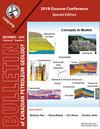加拿大东海岸拉布拉多海Saglek盆地;地层学、构造与含油气系统
Q3 Earth and Planetary Sciences
引用次数: 11
摘要
Saglek盆地是加拿大东海岸拉布拉多边缘的两个主要沉积盆地中较北的一个,在20世纪70年代至80年代初进行了勘探钻探。Saglek盆地面积超过10万平方公里,包含晚白垩世至更新世的碎屑岩为主的演替。Saglek盆地共钻了9口井,仅有1口有重大发现。Hekja O-71井位于Frobisher Bay以东的盆地北半部,该井的天然气含凝析油,储量估计约为6.51 × 1011立方米(2.3万亿立方英尺)。对地震和海洋布格重力数据的新解释表明,重新激活的基底结构对上覆剖面的影响非常大。沿拉布拉多海地震带的地震活动被认为是热成因天然气通过预先存在的裂缝网络间歇性喷发的可能原因。这可能解释了卫星雷达资料观测到海面上持续浮油特征的原因。在盆地南部出现这些石油渗透指标,意味着存在一个更容易产油的第二含油气系统。烃源岩分析表明,盆地裂谷后演替中有3组具有油气源潜力。以往的研究提出了这些岩石热成熟度不足的问题,降低了盆地的石油潜力。一项综合的4-D盆地建模研究显示,在一些储层和盆地深处的自产石油厨房中,天然气产量估计为2.83 × 109立方米(100万亿立方英尺),并伴有少量石油成分。沿着盆地西侧解释了三个独立的勘探航道。总的来说,这些观测表明Saglek盆地的石油潜力可能比以前估计的要高得多。本文章由计算机程序翻译,如有差异,请以英文原文为准。
Saglek Basin in the Labrador Sea, east coast Canada; stratigraphy, structure and petroleum systems
Abstract Saglek Basin is the more northerly of the two major sedimentary basins along the Labrador margin of the Canadian east coast in which exploration drilling was undertaken in the 1970s-early 1980s. Saglek Basin has an area of over 100,000 km2, and contains a clastic-dominated succession of late Cretaceous to Pleistocene age. Nine wells were drilled in Saglek Basin, with only one significant discovery. The Hekja O-71 well, drilled in the northern half of the basin just east of Frobisher Bay, flowed natural gas with condensates and has reserves estimated at approximately 6.51 × 1011 m3 (2.3 Tcf). A new interpretation of seismic and marine Bouguer gravity data shows the very strong influence of reactivated basement structures on the overlying section. Earthquake activity along the Labrador Sea seismic zone is proposed as a possible cause for episodic venting of thermogenic natural gas through pre-existing fracture networks. This may account for the observations of persistent oil slick features on the sea surface observed in satellite radar data. The presence of these oil seep indicators in the southern part of the basin implies the existence of a second petroleum system that is more oil prone. Source rock analysis indicates that three formations in the post-rift succession of the basin have petroleum source potential. Previous studies have raised the issue of inadequate thermal maturation of these rocks in downgrading the petroleum potential of the basin. An integrated 4-D basin modelling study, that shows significant natural gas generation, estimated that volumes of 2.83 × 109 m3 (100 Tcf) could occur, along with a minor oil component, in self-sourced petroleum kitchens in some reservoirs and from sites deeper in the basin. Three separate prospect fairways are interpreted along the western side of the basin. Collectively, these observations suggest the petroleum potential of the Saglek Basin may be significantly higher than estimated previously.
求助全文
通过发布文献求助,成功后即可免费获取论文全文。
去求助
来源期刊

Bullentin of Canadian Petroleum Geology
Earth and Planetary Sciences-Geochemistry and Petrology
CiteScore
2.50
自引率
0.00%
发文量
0
期刊介绍:
The Bulletin of Canadian Petroleum Geology is a peer-reviewed scientific journal published four times a year. Founded in 1953, the BCPG aims to be the journal of record for papers dealing with all aspects of petroleum geology, broadly conceived, with a particularly (though not exclusively) Canadian focus. International submissions are encouraged, especially where a connection can be made to Canadian examples.
 求助内容:
求助内容: 应助结果提醒方式:
应助结果提醒方式:


